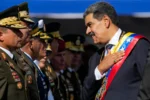Last week, Russia initiated a deadly rocket attack on the southern Ukrainian city of Odesa, precisely when Greek Prime Minister Kyriakos Mitsotakis was visiting the port of Ukraine.
“We heard the noise of sirens and explosions that occurred near us,” said Mitsotakis, emphasizing that there was no time to reach shelter.
However, he said, “we will not be intimidated.”
This incident sparked international outrage because the Russians struck less than a kilometer away from the Greek Prime Minister, writes yahoonews.
In the two years since Russian President Vladimir Putin began full-scale occupation of Ukrainian territories, many personalities visiting Ukraine have faced attacks nearby.
Sirens also sounded during the visit of US President Joe Biden to Kyiv in February last year.
Many of these attacks killed Ukrainian civilians, which is part of Putin’s operations.
It is unclear whether these incidents represent a single strategy or are actually deliberate, according to Christian Nitoiou, a lecturer in diplomacy and international governance at Loughborough University in the United Kingdom.
“Certainly, I think Russia is trying to intimidate Western leaders,” Nitoiou said.
However, he doubts whether there is a plan “to actually kill or target a key politician from the EU or the USA.”
So, there is a clear threat.
Even in February, a Russian drone attacked German Defense Minister Annalena Baerbock in the southern city of Mykolaiv, causing her and her group to flee.
Both Nitoiou and Rafael Loss, a policy fellow at the European Council on Foreign Relations, believe that these events should lead to intensive diplomatic discussions with Moscow.
This is because incidents like these signal that Russia is willing to escalate the conflict.
What happens if someone gets hit?
Imagine for a second if one of these world leaders is actually hit.
NATO’s principle of collective defense – Article 5 – would not apply in this case, as the attack did not occur in NATO territory.
However, Article 4, where NATO member states consult with each other on how to respond to the attack, could be triggered.
“And from this, a kind of diplomatic, political, economic, or even military response could emerge,” Loss said.
However, how a affected country reacts may also depend on the severity of the attack, Nitoiou stated.
Countries like Poland and the Baltic states, which have long been wary of their neighbor due to the possibility of a larger conflict, are more likely to escalate with unilateral actions.
According to Nitoiou, the most likely scenario is that none of Ukraine’s allies will choose military escalation.
With these attacks, Russia is testing NATO’s stance against the threat. This is because incidents that occur while world leaders visit Ukraine are part of a broader strategy of provocations.
“Any conflict can be described as a kind of slippery slope toward escalation, but I think over the past two years Russia has deliberately greased the slope,” Loss said.
He also noted the moment when a Russian missile was believed to have entered NATO airspace over Poland.
Such actions seem to aim to manipulate the stance of Ukrainian allies.







